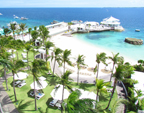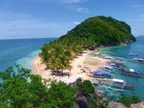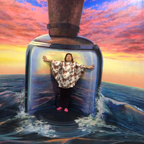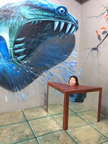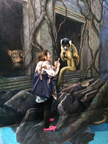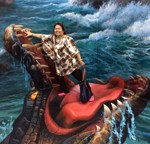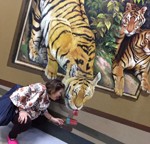On my recent visit to the Philippines, I decided to take the day tour to Corregidor. For the longest time, I remember this as past of our Philippine History in high school. I really did not have a clue to which province this island belong. So I did my research from my friendly Wikipedia to share some information you might want to know before you go on the Corregidor day tour. The guide we had was very knowledgeable but I did not have my pen and paper to write everything about what she said. All I know that it was very hot that day and all the ruins from the war is such a view to see.
Corregidor Island, locally called Isla ng Corregidor, is an island located at the entrance of Manila Bay in southwestern part of Luzon Island in the Philippines. Due to this location, Corregidor has historically been fortified with coastal artillery to defend the entrance of Manila Bay and Manila from attacks by enemy warships. Located 48 kilometres (30 mi) inland, Manila has been the largest city and the most important seaport in the Philippines for centuries, from the colonial rule of Spain, Japan and the United States, to the establishment of the Philippines in 1946.
Corregidor (Fort Mills) is the largest of the islands that formed the harbor defenses of Manila Bay, together with El Fraile Island (Fort Drum), Caballo Island (Fort Hughes) and Carabao Island (Fort Frank), which were all fortified during the American colonial period. The island was also the site of a small military airfield, as part of the defense.
During World War II, Corregidor played an important role during the invasion and liberation of the Philippines from Japanese forces. The island was heavily bombarded during the latter part of the war, and the ruins serve as a military memorial to American, Filipino and Japanese soldiers who served or lost their lives on the battlefield. Corregidor is one of the important historic and tourist sites in the country.
Topside
The island’s biggest area, which points towards the West Philippine Sea, rises prominently to a large flat area that is called “Topside”. Beneath this was the fortified communications center of the island, as well as the location for the Army headquarters, barracks for enlisted men, a branch of the Philippine Trust Co. bank, the Cine Corregidor movie theater, officers’ quarters, underground ordnance shops, the parade ground, an Officers’ Club with a 9-hole Golf Course, tennis courts, and swimming pool, and the bulk of the artillery batteries that constituted the strength of Corregidor.
Middleside
Middleside is a small plateau that interrupts the upward slope from Bottomside to Topside, and was the location of 2-story officers’ quarters, barracks for the enlisted men, a hospital, quarters for non-commissioned officers, a service club, PX, and two schoolhouses—one for the children of Filipino soldiers and the other for American children.
Bottomside in 1982
Bottomside is the lower part of the island and is the neck that connects the tail and head of the island. South of Bottomside was Barangay or Barrio San José (near what was Navy Beach); on the north is what was Army Dock, with its three large piers, and, east of Bottomside, is the Malinta Tunnel. The Malinta Hill separates Bottomside from the Tail End.
Tailside
The Tailside or Tail End is not a given name, but it is the remaining portion of the island where different memorials, shrines and the island’s airstrip are located. Kindley Field was constructed in the early 1920s and named in honor of an early hero of the U.S. Army Air Corps. The airfield was operated then by the army, and the navy had a seaplane base. The short runway, cramped and hilly terrain had limited its use.
Source: Wikipedia
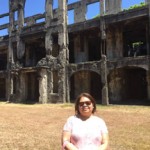
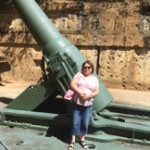
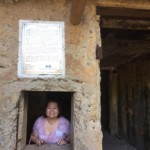
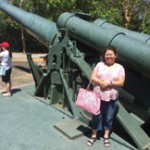
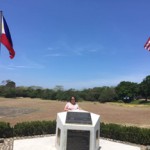
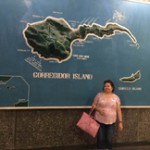
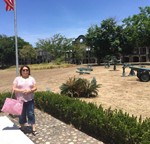
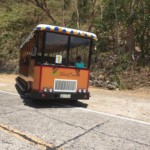
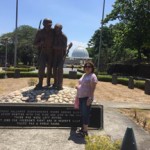 ]]>
]]>I have lived in Calgary for over 22 years but for some reason, I’ve never experienced the real essence of Holy Week except for Good Friday. So this year, I decided to visit Manila just in time for the Holy Week and promised myself that I will do what I’ve been hearing before from other Filipinos which is the VISITA IGLESIA. So here is a short background of how this tradition during the Holy Week all started.
The Seven Churches Visitation is a pious Roman Catholic Lenten tradition to visit seven churches on the evening of Maundy Thursday. Following the Mass of the Lord’s Supper, the Blessed Sacrament is placed on the Altar of Repose in the church for Adoration. During the Seven Churches Visitation, the faithful visit several churches – sometimes seven, sometimes fourteen, sometimes no set number depending upon the particular practice – to pray before the Blessed Sacrament in each church. The tradition of visiting seven churches on Holy Thursday probably originated in Rome, as early pilgrims visited the seven basilicas as penance.
In the Philippines, the tradition is known as Visita Iglesia. The general practise is to visit seven churches either on Maundy Thursday or Good Friday and recite the Stations of the Cross. The pious and able would double the number of churches to fourteen, while the infirm and elderly usually visit only one or a handful. Until the 1970s, people recited all fourteen stations in every church, but the more recent form is to pray two stations per church.
The more devout would carry a cross to each church, while others consider the ritual an opportunity for sightseeing. An offering is usually made at each church and to the poor as a form of almsgiving. To accommodate the faithful, many Catholic churches during Holy Week remain open until midnight. While traditionally done on Maundy Thursday, after the Mass of the Last Supper, it is now common to perform Visita Iglesia on any day during Holy Week.
Since 2010, a bicycle tour known as the Bisikleta Iglesia has also been organized, where the pilgrimage is conducted by biking on a route covering the seven churches.
These are the 7 churches that I visited for the first time that I was in Manila for VISITA IGLESIA:
- OUR LADY OF MT. CARMEL CHURCH (Lipa, Batangas).
- METROPOLITAN CATHEDRAL OF SAN SEBASTIAN (Lipa, Batangas)
- ST. BENEDICT MONASTERY (Lipa, Batangas)
- INVENCION DE LA STA. CHURCH (Alitagtag, Batangas)
- SAN ROQUE PARISH CHURCH (Lemery, Batangas)
- ARCHDIOCESAN SHRINE OF OUR LADY OF CAYSASAY (Agoncillo, Batangas)
- BASILICA OF ST. MARTIN DE TOURS (Taal, Batangas)
At the end of the tour, I felt fulfilled that I did what I had planned to do before I left Calgary. I was able to stand the traffic and the heat during our whole trip ahd saw these churches that are vey significant to each town. I can say that my trip was well worth it because Holy Week is a very important tradition in our religion as Catholics. So next time you plan to go back home, think if you would like to have the same experience and for my opinion, you’ll never regret it.
Source for the backgrounder: wikipedia
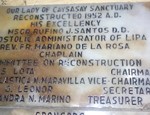


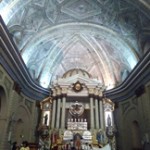
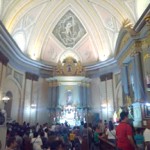

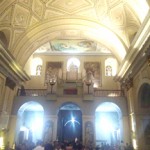
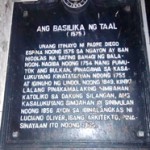
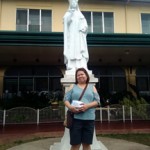
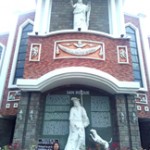
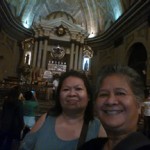
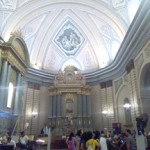
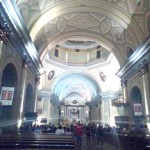
 ]]>
]]>Big Valley, a small village of 364 people is the destination for the Alberta Prairie Steam Train, which travels from Stettler to Big Valley. We took that excursion about 20 years ago and highly recommend it. You may have also heard of the Big Valley Jamboree, an outdoor country music festival held nearby in Camrose Alberta every August.
Big Valley has one of the last remaining turntable and roundhouses in Canada, built in 1912. They also have a great railway museum – The Canadian Railway Hall of Fame. We enjoyed our picnic lunch in a cool park setting and on foot, took a stroll throughout the village. Be sure to tour the Jimmy Jock Boardwalk, a small restored town site and leave time to check out the several museums housing vehicles and equipment from the early 1900s. Another beautiful sight is the St. Edmunds Church, built in 1916 and the water tower overlooking Big Valley. Don’t miss the Big Valley Jailhouse which was built in 1914 too. Several antique stores also allow you to pick up unique gems at a fraction of the price of the big city.
Rather than returning to Calgary on the congested and dangerous Hwy #2, you can return by going through Drumheller. If you do make sure you stop by the little restored ghost town of Rowley Alberta, population – 10. Several movies have been made there and the town kept the sets and buildings and restored them.
Since my wife and I have been to Drumheller about 30 times it is considered boring to us but since it was a Saturday evening, we went to Dinosaur Downs Raceway there and watched an exciting evening of car racing on the dirt oval track. We then headed home with a beautiful sunset to view along the way.
Although Pinoy Times can only show 5 or 6 photos from this day trip, and we took several hundred, check us out on Facebook for more. Along the way we spotted deer, sheep, cattle, llamas and herds of buffalo and elk. All in all, a full day of sightseeing – made better by pre trip planning and research, and we discovered a few more Alberta gems!
Steve Tarzwell
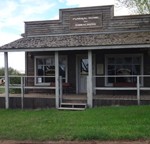
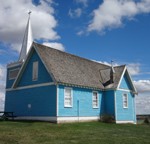
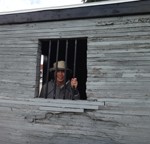
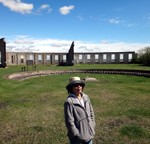
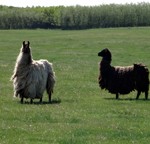
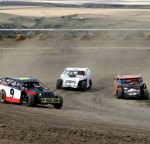 ]]>
]]>We began our walking tour near and around 1st Avenue and 9th Street N.E. (lots of free parking) after taking care of business. Inside of 3 blocks in any direction from that point there are scores of parks and green spaces, plus remarkable views of downtown and the Bow River Valley. Numerous new condos and apartments have also popped up. The older homes have been skillfully restored and the mature trees indicate that this is not a new neighborhood but a well established part of our city. Alberta Health Services has built a few fancy buildings nearby and there have always been quite a few Senior’s long term care homes in Bridgeland. The commercial area, 1st Avenue, is unique in that throughout the businesses, restaurants and coffee shops there is a sprinkling of accessible Senior’s services such as Doctors, Dentists and Hearing Centres.
Although the Calgary Zoo is within the boundaries of Bridgeland, it continues to gobble up taxpayer’s dollars by the millions, while killing many rare and exotic animals – penguins, stingrays, hippos, 85 talapia fish, a caribou calf, a giant capybara, a corn snake etc. and doesn’t rate any further comment by me.
The beautiful “Tom Campbell’s Hill Natural Park” and the recently rebuilt St. Patrick’s Island Park are also features of Bridgeland but we didn’t visit them this time around. Bridgeland is home to the Langevin Science School with their many stunning murals and the area also has at least 8 historical old church buildings that have been carefully restored and are still in use.
Bridgeland is centrally located, has easy access to downtown and the river valley, a C-Train station and some main streets to get out of town. I was surprised to see that most of the dining choices in the commercial district are of an upper class nature, yet mid range for pricing. No McDonald’s, no Tim Hortons Coffee Shop and only one big name convenience store – makes the 1st Avenue business area great for a stroll and window shopping.
The business we had in Bridgeland was to view, test and check out a new bicycle for my wife. We did that and chose a beauty for her to enjoy. I encourage you to check out “Bike and Brew” at 9th St. and 1st Avenue N.E.. Friendly, knowledgeable sales and service staff plus Ludy and I enjoyed specialty coffees and baked goods while she made her decision.
While finding my wife’s Birthday/Mother’s Day/Anniversary gift, we had a scenic walk throughout a really nice part of Calgary. Bridgeland, with its’ many murals, well kept homes and gardens, easy parking and access to everything you need in life – is one of Calgary’s best unknown communities!
We have a big, beautiful and most interesting city. Explore it today!
Steve Tarzwell

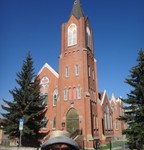

 ]]>
]]>
Boracay is a small island in the central Philippines. It’s known for its resorts and beaches. Along the west coast, White Beach is backed by palm trees, bars and restaurants. On the east coast, strong winds make Bulabog Beach a hub for water sports. Nearby, the observation deck on Mount Luho offers panoramic views over the island. Offshore, coral reefs and shipwrecks are home to diverse marine life.
Bohol is a province of the Philippines, in the country’s Central Visayas region. It comprises Bohol Island and numerous smaller surrounding islands. Bohol is known for coral reefs and unusual geological formations, notably the Chocolate Hills. On the main island, near the town of Carmen, these 1,200 or so symmetrical mounds turn cocoa-brown in the dry season, contrasting with the surrounding jungle’s greenery.
Offshore from the southwestern capital, Tagbilaran, is Panglao Island. The island’s has beach resorts and renowned dive sites around south-coast Alona, as well as diving schools and opportunities for dolphin-watching. Inland, the forest of the Rajah Sikatuna Protected Landscape is popular for bird-watching and trekking. The Tarsier Sanctuary in Corella helps preserve the endangered Philippine tarsier, a tiny, bug-eyed primate. Wooden boats serve traditional buffets as they follow the Loboc River to Busay Falls. Around Antequera are caves and waterfalls.
El Nido is a Philippine municipality on Palawan island. It’s known for white-sand beaches, coral reefs and as the gateway to the Bacuit archipelago, a group of islands with steep karst cliffs. Miniloc Island is famed for the clear waters of its Small and Big lagoons. Nearby Shimizu Island has fish-filled waters. The area has many dive sites, including Dilumacad Island’s long tunnel leading to an underwater cavern.
The laid-back town of El Nido is a base for island-hopping tours, and kayaking trips to mountainous Cadlao Island, just across the bay. Taraw Peak can be reached by climbing steep, jagged cliffs for a bird’s-eye view of El Nido town and its horseshoe-shaped cove. North of town, the twin beaches of Nacpan and Calitang curve in opposite directions, featuring white sand and tall coconut palms. The cold waters of Nagkalit-kalit Falls are a popular swimming spot.
Cebu is a province of the Philippines, in the country’s Central Visayas region, comprising Cebu Island and more than 150 smaller surrounding islands and islets. Its prosperous port capital, Cebu City, retains landmarks from its 16th-century Spanish colonial past, including the Basilica Minore del Santo Niño church and triangular Fort San Pedro. Tops, an observation deck on Mt. Busay, has sweeping views over the city.
Cebu City is also a gateway to the region’s renowned dive sites and beach resorts. Throughout the province, divers and snorkelers can see whale sharks, turtles, hammerheads and rays among coral reefs, caves and steep walls. The west-coast town of Moalboal has several dive sites, modern resorts, nightlife in Panagsama and the sandy White Beach. Off the north coast of Cebu, tiny Malapascua Island has laid-back beaches and simple resorts, with renowned diving among thresher sharks offshore. Northwestern Bantayan Island focuses on beach life, centered around the village of Santa Fe.
Davao City, on the southern Philippine island of Mindanao, is a coastal commercial center near 2,954m-high Mount Apo, the country’s highest peak. In the city center, People’s Park is known for its colorful indigenous sculptures and lighted fountains. It’s also home to Durian Dome, named after the pungent, spiky fruit that grows in abundance on Mindanao. The Davao River cuts through the city.
Along the river banks are green spaces and the Davao Crocodile Park, a zoo with a variety of wildlife. Upriver are rapids for rafting. Elsewhere, the Philippine Eagle Center provides a rainforestlike home for the endangered giant raptors. Notable cultural institutions include the Museo Dabawenyo, exploring the region’s heritage, and the Davao Museum of History and Ethnography, focusing on the Mindanao tribes. The large Lon Wa Buddhist Temple is known for its statues and elaborate wood carvings. Samal Island, just off the coast, is a resort area with beaches and snorkeling.
Baguio, on the Philippines’ Luzon island, is a mountain town of universities and resorts. Called the “City of Pines,” it’s particularly popular in summer due to unusually cooler weather. At its center is Burnham Park, with gardens and a lake. Nearby, Baguio Cathedral, completed in 1936, has a rose-hued exterior. The main thoroughfare is Session Road, lined with shops, restaurants and entertainment options.
Former U.S. military facility Camp John Hay is a hillside holiday complex with a golf course and forest trails. The expansive Botanical Garden neighbors Wright Park, home of the picturesque Pool of Pines, and The Mansion, the presidential summer residence. Elsewhere, the BenCab Museum exhibits the work of Benedicto Cabrera and other Filipino artists amid landscaped grounds. Tam-Awan Village is an artists colony with traditional huts and views out to the South China Sea. Overlooking Baguio, 2,000m-high Mount Cabuyao has hiking and biking trails.
Vigan is a city in the Philippines, on the west coast of Luzon island. It’s known for its preserved Spanish colonial and Asian architecture. Calle Crisologo dominates the Mestizo district, with its cobblestone streets, malecón, horse-drawn carriages and rustic mansions. Near the white baroque Vigan Cathedral are Plaza Salcedo, offering fountain light shows, and Plaza Burgos, known for its street-food stalls.
Next to the cathedral, the 18th-century Archbishop’s Palace is distinguished by its sliding capiz windows. Inside the palace, the Museo Nueva Segovia contains religious relics from various churches in the region. Formerly the home of the Crisologos, a powerful political family, the Crisologo Museum displays personal memorabilia and period furnishings. A branch of the National Museum, Padre Burgos House features regional artifacts and artworks, including a series of paintings of the 1807 Basi Revolt against the Spanish.
Iloilo City, officially the City of Iloilo, is a highly urbanized city on southeastern tip of Panay island in the Philippines. It is the capital city of the province of Iloilo where it is geographically situated but governed administratively independent from it. In addition, it is the center of the Iloilo-Guimaras Metropolitan Area, as well as the regional center of the Western Visayas region. In the 2015 census, Iloilo City had a population of 447,992, with a 1.02% population annual growth rate. For the metropolitan area, the total population is 946,146. Iloilo City is bordered by the towns of Oton in the west, Pavia in the north, Leganes in the northeast and the Iloilo Strait in its eastern and southern coastline. The city was a conglomeration of former towns, which are now the geographical districts consisting of: Jaro, Molo, La Paz, Mandurriao, Villa Arevalo and Iloilo City Proper. The district of Lapuz, a former part of La Paz, was declared a separate district in 2008.
Sagada is a town in the Cordillera Mountains, within the Philippines’ Mountain Province. Echo Valley’s hanging coffins are displayed high on cliffs, while centuries-old coffins are stacked in burial sites like Lumiang Cave. The nearby Sumaguing Cave has unusual limestone formations. To the north, Bomod-ok Falls has a natural swimming pool. Rice terraces are carved into the area’s surrounding mountainsides.
Siargao is a tear-drop shaped island in the Philippine Sea situated 800 kilometers southeast of Manila in the province of Surigao del Norte. It has a land area of approximately 437 square kilometres. The east coast is relatively straight with one deep inlet, Port Pilar. The coastline is marked by a succession of reefs, small points and white, sandy beaches. The neighboring islands and islets have similar landforms. The island is composed of municipalities of Burgos, Dapa, Del Carmen, General Luna, San Benito, Pilar, San Isidro, Santa Monica and Socorro.
]]>When we travel from Calgary to Banff we take a short break at the rest stop at Lac des Arcs, the lake about 18 km. east of Canmore on Highway #1. Most people remember the area as it has a huge cement plant on the far side of the lake. On the other side of the highway across from the rest stop there is an easy 2 km. long trail to these abandoned caves and it can be used year round. Great views of the lake while walking along the hiking trail are an added bonus. The best thing is – it is another FREE! Alberta sight, plus there are washrooms at the start of the trail.
Bring along a couple of good flashlights and a picnic basket and make a day out of it. If you want to make a full day outing and you still have time after the bunkers, I would also recommend a leisurely walk along the Heart Creek Trail, starting east from the same parking lot. This trail takes you over 9 bridges with falls at the end of the easy trail.
Let’s get out and enjoy Alberta’s beautiful and natural attractions!
Steve Tarzwell



 ]]>
]]>A couple more km. down this road and I arrived at Cayley, Alberta, population 265. There is not a lot to this town, although it does have one grocery store…
I continued driving around Cayley as I had heard that there is a unique assembly of old Avro Anson aircraft in the area. I found it on the edge of the town. This Art Installation, built in 2009 is called Gravitas. The airplanes are training aircraft left over from World War II and there are 12 of them arranged in a circle 75 Metres across. The information I had gathered before my trip indicated that the display is better viewed from the air and I agree. Also, right next to it is another strange type of home – with several funny shapes to it.
Satisfied that I had seen what I came for around Cayley, I returned north on Hwy #2 just a few km. to get to Secondary Road #540 West. This little travelled road winds back and forth and up and down through beautiful prairie grasslands, with the majestic snow covered Rocky Mountains in the background. There are many large rock outcroppings, scenic winding creeks and an abundance of wildlife. What a splendid day just to be alive and driving around!
I stopped to eat my customary picnic lunch and thermos of coffee and relaxed, dreaming about my wife in the Philippines, on vacation on the other side of the world – me, enjoying the peace, tranquility and fresh air while she is visiting family and friends back home. What a contrast!
Continuing west on Hwy #540 I soon came to the world famous Bar U Ranch National Historic Site. Set in the rolling foothills of the Rockies, the Bar U Ranch is the only national historic site to commemorate the history and importance of ranching in Canada. The site has many historic buildings and structures, illustrating various stages of ranching development, and is rich in cultural landscape features. A visitor centre and a vibrant living history program interpret a time when the West was young. Although it was closed on this day, further research tells me two important details – it opens for the 2017 season on May 15 AND because it is the 150th Anniversary of Canada’s National Parks – admission is FREE! Be sure to add it to your to do list for 2017.
Deciding that it was still too early to return to Calgary, I took a peaceful drive down the road past Bar U Ranch, a gravel road that follows the tiny Pekisko Creek. It was stop and go as I found many interesting things within 10 km down this road, as well as frequent scenic points along the way. At the end of the road I came upon another sight – again, one I will check out this summer when my wife is back. This great discovery is the EP Ranch/D Ranch. The E.P. (Edward Prince) Ranch cultural landscape is a 41 hectare ranch headquarters, situated adjacent to Pekisko Creek, in a rural setting in the foothills of Alberta. The site comprises: a 1927 Ranch House addition constructed for the Prince of Wales (later His Majesty King Edward VIII); a collection of log and wood frame residential and agricultural buildings and structures dating from the late 1880s; a formal garden; irrigated working gardens; woodland paths; shelter belts; and archaeological remains of early homestead-era structures. The return trip later this summer will be exciting for sure.
I returned to the main highway full of more ideas for later trips and headed north on Hwy #22 – The Cowboy Trail. My wife and I have explored the Cowboy Trail south of Hwy #22X more than 20 times over the past few years. If you haven’t – then I suggest you check out Longview, Black Diamond, Turner Valley, Milliarville and Priddis. They all have lots to offer and each one makes a great day trip. Summer is coming, start planning your weekends now!
Steve Tarzwell




 ]]>
]]>Before you start thinking that I will tell you all about a Provincial Park, you must remember that it is still winter. Few people, if any, go to Provincial Parks in January. For the record though, Ram Falls Provincial Park is one of Alberta’s best parks in the summer, for families and outdoor types, those who can live without showers, flush toilets or cell phones. It is very remote and you WILL have bears going through your campsite, so if you are the type that leaves food, utensils, cooking oils or garbage out – please stay home in the city.
However, I will tell you about Ram Falls themselves, in the winter.
I loaded up with my food for the 2 days, some cookies, a bag of chips, one bottle of water and 2 pieces of leftover turkey drumsticks from Christmas. That’s right – you don’t need a 2 week supply of food for a weekend, even if you are Filipino. The goal should be to consume whatever you bring as it doesn’t make sense to come home with leftover food. Yes, you will probably need a bit more than I did but be reasonable.
Ram Falls is about 80 km. south of Nordegg, Alberta. If you are interested, be independent and GOOGLE it yourself for more information and directions. The only mistake I made for the weekend was that I thought of economics. (If you do a trip cheaply – you can take another one the next weekend) I decided to take my wife’s fuel efficient little car and left the bigger, 4 wheel drive vehicle at home. Big mistake when you’re heading to the mountains in winter time. If you spend your entire life in the city where snow is measured in cm. then you can only imagine traveling to an area of Alberta that measures snowfall in metres! From Nordegg, Alberta and further west there is almost 1.5 metres of snow on the ground. Unlike city slickers who are protected at a huge cost to taxpayers, the roads there are seldom sanded or salted. The resulting hard packed icy snow covered roads should only be driven on using a vehicle designed for Canadian winters. That rules out Hondas and Toyotas which are engineered to look pretty while you cruise to the Mall.
Along the way there are a lot of interesting things, including the little town of Nordegg. It is your last stop for fuel for a long time, so fill up there for sure. Also, you will probably see a few of Alberta’s wild horses as they frequent this part of the province. They dig through the snow and eat the grass below, and are very timid and will take off if you stop and try to get to close.
The last 65 km. of driving I did before arriving at the hiking trail to Ram Falls was really the highlight of the weekend. 65 km. in and 65 km. out, not another vehicle did I meet. This is on a forestry trunk road and really leads from nowhere to nowhere, at least in the winter. That is good because the road is single lane and if you get too far to one side or the other you will disappear over a cliff. If you survive the wreck, it may still be days before anyone finds you. And forget your useless cell phone. There is no coverage in the area and no humans for 80 km. or more.
The 65 km. journey off the main highway took me 3 hours to complete. Not a problem, it is not like the rush, rush, rush of city folk anyway. I stopped numerous times at frozen rivers, frozen lakes and even the trees had so much snow on them you couldn’t see their branches or needles. Always, in the background of the scenery, as this area is in the foothills, are the majestic snow covered Rocky Mountains.
Thinking ahead, when I arrived at Ram Falls Provincial Park, I left the little front wheel drive car at the gate. Getting it stuck in the deep snow in the parking lot, with no one else around, was not on my agenda.
The 3 km. trail on foot through 75 cm. of snow was a fine workout and was good exercise for me. Perhaps I could have brought snowshoes or skis but those are for wimps and take up space in the car.
Although the drive to and from the Park was difficult – the destination proved it was all worth it! At this time of year the river and falls are all ice. The thing is – under the thick ice the water is still flowing. Yes, even the falls from top to bottom are solid ice with water flowing under it! Spectacular indeed!
Our tax dollars have provided stairs, about 200 of them, and a lookout so you can see the falls better. While viewing, and of course taking pictures, I thought, these falls would be even more awesome in the spring when the river is high with the melting snow. I vowed to return with my wife for a weekend of camping, especially as Crescent Falls and Abraham Lake are also close by.
If you really are serious about getting away from the hustle and bustle of city life, for good health, less stress and lower blood pressure, I recommend Ram Falls. I caution you though, if you go summer or winter and don’t have 40-50 years of driving experience, Message me and I could give you some tips that could save your life and the lives of those you love. Anyone can head out on the 4 lanes of bare pavement to Banff or Lake Louise. Ram Falls is a different story!
Steve Tarzwell




 ]]>
]]>st of my former student on fb about this museum. I was amazed with how the pictures looks so real. I asked her where this place was and she said it’s in Quezon City and it’s called Art in Island. So I told myself that if ever I will go back to visit my home country, I will never miss to visit this newest place for art.
The biggest trick art museum in Asia, Art in Island, opens on Christmas Day in Cubao, Quezon City! This museum can be compared with the Trick Art Museum in Jeju Island, South Korea is currently the largest with a floor area at 4,100 sq m,. But in terms of the total painted area, Art in Island, this newest attraction in Cubao is now the largest 3D interactive art museum in Asia. It took me at least least two to three hours to enjoy all the themed galleries.
Also known as “optical art” or “3D art”, “trick art” are mostly two-dimensional images that give the illusion of the third dimension: depth. Art in Island has over 50 trick art murals painted by a team of 18 Korean master painters who were specially flown in for the project. Funny caricature sculptures of the artists are displayed at the lobby before you enter the galleries. Since shoes are not allowed inside the galleries to preserve the painted areas on the floor, comfortable bedroom slippers are for sale to visitors.
People responsible for having the very first kind of this museum in Manila is none other than Korean CEO Yun Jae Kyoung and marketing officer Margarette Mamauag. The comical and surreal works of art, which were conceptualized and designed by a team of Korean and Filipino designers. There are also optical illusion set-ups that will trick your perceptions and help you create unbelievable photos. I would really recommend that you add this in your itinerary when you visit Manila to see for yourself the element of surprise.
The Korean-owned museum has definitely added a fun and colorful dimension to an otherwise drab street off Aurora Boulevard. Considering the Filipino penchant for taking “selfies” and snapping pictures in general, Art in Island will surely be a hit with family and barkadas.
You will find the museum at 175 15th Avenue, Barangay Socorro, Cubao, Quezon and they are open from 9:30 AM to 9:30 PM . Entrance fees are PHP 500 for adults and PHP 400 for students.
]]>Driving west on Highway #1, I decided to cut over to the north, on Morley Road and check out a couple of destinations on Highway #1A. Crossing the bridge over the Bow River at Morley, I was surprised to see so much ice jamming up the river. Considering that winter has barely begun, it could be an interesting spring – bringing back memories of the flooding we had a few years ago.
After crossing the bridge I took Highway 1A west heading towards destination #1. This highway, although snow covered, is not very busy in the winter and allows me to take a relaxing cruise – much different than the suicidal drivers on Highway #1. It even lets me stop along the way when I see something scenic or to take photos of wildlife. This I did many times, as I was not in a hurry. The panic of Christmas had passed and the foolishness of New Years Eve was still a few days away. The sun was shining and it was a beautiful day to be alive!
25 km from Morley I arrived at the Seebee Dam on the Bow River. The Seebee Dam was built in 1913 at a point where the Bow and Kananaskis Rivers meet. The dam is operated by Trans-Alta Utilities and is used to generate electricity. The town of Seebee does not exist anymore. Although more spectacular in the spring, the dam is still an awesome sight in the winter with huge piles of ice on it. Happily, I was alone, although a couple of guys stopped by to check the ice conditions for a later climb. Carefully climbing among the rocks, both above and below the falls, I was able to capture the beautiful scenery with a backdrop of the snow covered Rocky Mountains. Whenever I see such magnificent views, I feel sympathy for those who choose shopping malls and TV as a choice of entertainment. I frequently hear people speak of the beauty that God has given us – but few of them actually get out and enjoy it! Perhaps they just view the pictures and experiences of those who are more inclined to make an effort to see nature – alive and in color!
While basking in the warming sun, snacking on leftover Christmas turkey and chocolates, I thanked the Lord for these and many Blessings He has given me. I thanked Him for getting my wife Ludy to the Philippines and Prayed that He would protect her from the pollution, heat, crime and calamities while she visits her 92 year old Mom and our daughter Stephanie. God is good!
I reluctantly packed up and headed towards my second destination of the day, aware that with our shorter days in winter that it would cool down earlier. I drove slowly east on Highway #1A passing the Morley turnoff again, but staying on 1A. I was surprised to see only one car in the ditch along that whole 40 km stretch and no surprise, it was a Honda. Destination #2, Ghost Lake, made me happy as soon as I arrived. The summer crowds were not there – only about 20 ice fishermen, with maybe a dozen vehicles parked on the frozen lake. For comfort and convenience about 6 of them had erected tents, ice huts or some kind of shelter while they fished through holes drilled in the ice. As Ghost Lake is huge, I was able to spot various snowmobiles, four wheelers and even 4 X 4’s having fun on the lake, doing donuts and sliding around in circles. Even though there is only about 30 cm of ice on the lake this early in the winter, what a feeling it is to walk or drive on “water”. The ice is continually creaking, cracking and heaving so it is not for the faint of heart. It doesn’t scare me a lot as I have been on frozen lakes many times over the years. 10 cm is enough thickness of ice to hold most vehicles so we were not in danger.
With about 30 cm of snow on the ground around the lake and adjacent parking lot, it is entertaining to watch other vehicles stop by on their trips. I always get a chuckle out of those who head to the mountains in the winter – clad in useless running shoes, leather jackets and no toques. They pile out of their vans, take pictures of themselves and 60 seconds later jump back into their van and drive away. No doubt most of their day is spent just driving around looking out the dirty fogged up windows. They will never learn I guess…
I hope you are one of the few who has adapted to Canadian winters and pursues nature – prepared and ambitious enough to get out and experience it firsthand. It is a healthy and economical way to get the most out of life!
Have a great 2017!
Steve Tarzwell



 ]]>
]]>

